Fløibanen
The Fløibanen is a funicular railway in the Norwegian city of Bergen. It connects the city centre with the mountain of Fløyen, with its mountain walks and magnificent views of the city. It is one of Bergen's major tourist attractions and one of Norway's most visited attractions. The line is 844 m (2,769 ft) long, covers a height difference of 302 m (991 ft), and carries over 1 million passengers a year. The line is owned by Fløibanen SA, a company with a number of shareholders, the biggest being the municipality of Bergen.[1][2][3]
| Fløibanen | |||||||||||||||||||||||||||||||||||||||||||||||||||||
|---|---|---|---|---|---|---|---|---|---|---|---|---|---|---|---|---|---|---|---|---|---|---|---|---|---|---|---|---|---|---|---|---|---|---|---|---|---|---|---|---|---|---|---|---|---|---|---|---|---|---|---|---|---|
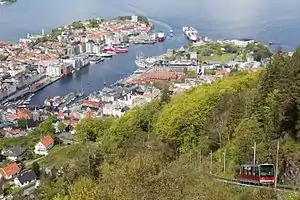 Fløibanen car Rødhette climbs above the city, as seen from the summit | |||||||||||||||||||||||||||||||||||||||||||||||||||||
| Overview | |||||||||||||||||||||||||||||||||||||||||||||||||||||
| Status | Open | ||||||||||||||||||||||||||||||||||||||||||||||||||||
| Owner | Fløibanen AS | ||||||||||||||||||||||||||||||||||||||||||||||||||||
| Termini | Vetrlidsalmenning Fløien | ||||||||||||||||||||||||||||||||||||||||||||||||||||
| Stations | 5 | ||||||||||||||||||||||||||||||||||||||||||||||||||||
| Service | |||||||||||||||||||||||||||||||||||||||||||||||||||||
| Type | Funicular | ||||||||||||||||||||||||||||||||||||||||||||||||||||
| Operator(s) | Fløibanen AS | ||||||||||||||||||||||||||||||||||||||||||||||||||||
| Rolling stock | 2 funicular cars | ||||||||||||||||||||||||||||||||||||||||||||||||||||
| History | |||||||||||||||||||||||||||||||||||||||||||||||||||||
| Opened | 1918 | ||||||||||||||||||||||||||||||||||||||||||||||||||||
| Technical | |||||||||||||||||||||||||||||||||||||||||||||||||||||
| Line length | 844 m (2,769 ft) | ||||||||||||||||||||||||||||||||||||||||||||||||||||
| Number of tracks | 1 with central passing loop | ||||||||||||||||||||||||||||||||||||||||||||||||||||
| Track gauge | 1,000 mm (3 ft 3 3⁄8 in) | ||||||||||||||||||||||||||||||||||||||||||||||||||||
| Operating speed | 6 m/s (19.69 ft/s) | ||||||||||||||||||||||||||||||||||||||||||||||||||||
| Highest elevation | 320 m (1,050 ft) | ||||||||||||||||||||||||||||||||||||||||||||||||||||
| |||||||||||||||||||||||||||||||||||||||||||||||||||||
History
.jpg.webp)
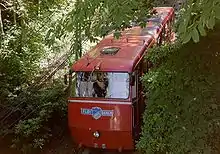
The idea to build a line to Fløyen was put forward in 1895 by John Lund, a local resident and member of the Norwegian legislature. Permission was granted by the city council, but the project was shelved after the necessary capital failed to be raised. A further proposal was put forward in 1907 and the company Fløibanen AS was founded to construct and operate the line in 1912. The line was modelled after other funicular railways in Germany, Switzerland and Italy, the design being most similar to that of the Merkur funicular in Baden-Baden.[4]
Work to build the line started in the autumn of 1914, with the expectation that construction would take from 12 to 18 months. However, with the cars being built by Maschinenfabrik Esslingen in Germany, and the rails being supplied from Switzerland, shortages caused by the outbreak of World War I delayed the work, and the Fløibanen was not officially opened until 15 January 1918. The original cars accommodated 65 passengers, and an operator at Fløyen controlled the 95 horsepower (71 kW) electric motor that hauled the cable at up to 2 metres per second (6.6 ft/s). The drivers on the cars communicated with the operator by using a pole to strike a signal wire suspended over the line.[4][5]
During World War II, the German occupying forces constructed many bunkers and other defensive features on the Fløyen mountain. The funicular was used to transport supplies and personnel, causing wear and tear to the cars and infrastructure. After the occupation ended, the two cars were first painted in contrasting colours from the Norwegian flag, with one car in red and the other in blue, a policy that has continued to this day. In 1950, the cable wheels and electric motor were replaced, allowing an increase in speed to 3.3 metres per second (11 ft/s). In 1954 the original cars were replaced with new cars supplied by Von Roll (underframes) and Hønefoss Karosserifabrikk (bodies). These cars accommodated 80 passengers, and the line was operated by drivers on each car, with no need for an operator at Fløyen.[4][5]
In 1974, the cars on the line were again replaced, with the new cars supplied by Von Roll and also able to carry 80 passengers. In 1987, the electric motor was replaced with a new 190 horsepower (140 kW) one, whilst at the same time the brakes and electrical systems were replaced. In 1997, the lower terminus was refurbished and extended. Between September and November 2002, a fourth generation of car was introduced to the line, built by Doppelmayr (underframes) and Gangloff (bodies). These cars are capable of carrying 100 passengers and equipped with bigger windows and glass roofs.[4][5]
Operation
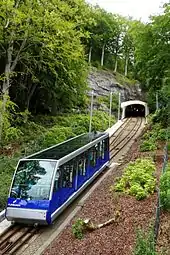
The Fløibanen has an overall length of 844 m (2,769 ft) with a height difference between the two terminal stations of 302 m (991 ft). The line is single track with a central passing loop. The lower terminal and first 150 m (492 ft) of the line is in tunnel, and there is a short tunnel above the passing loop, but the rest of the line is in the open air. The track is of 1,000 mm (3 ft 3 3⁄8 in) gauge and the gradient varies between 15 and 26 degrees.[5]
There are two cars, each of which can carry 100 passengers and weighs 11 tonnes empty or 19 tonnes when fully loaded. The cars have a stepped floor, large windows and a glass roof, in order to maximise visibility of the view whilst in transit. The cars are individually named and painted, with Blåmann in blue and Rødhette (Little Red Riding Hood) in red. Each car is operated by a driver, who occupies a cabin at the uphill end of the car irrespective of direction of travel.[5]
The drivers remotely control the speed of the cable, which is powered by a 315 kW (422 hp) electric motor and slowed by redundant braking systems, all located at the upper terminus. The cable itself is 950 m (3,120 ft) long, has a diameter of 40 mm (1.6 in), and has a breaking load of 66.5 tonnes. In the unlikely event of the cable breaking, the loss of cable tension would automatically cause track gripper brakes on each car to be deployed to bring them to a standstill.[5]
The line runs every day from early morning to late evening. In the early morning and late evening, departures are half-hourly, increasing to quarter-hourly during the day and more frequently at times of high demand. Two departures an hour stop at the intermediate stops, with other journeys running non-stop. In normal service the cars operate at 4 m/s (13 ft/s) but at times of high demand this can be increased to 6 m/s (20 ft/s). Depending on speed and stops, the journey takes between 5 and 8 minutes.[1][6][7]
The line has a manned ticket office at its lower terminus, and self-service ticket machines at all stops. Tickets can also be bought online, and either printed out or presented on a mobile device screen. Ticket barriers are in place at all stations, and tickets must be optically scanned to gain access to the platforms.[7]
The stepped floor of each car matches up with the line's stepped platforms, with four doors on each side. Wheelchairs and strollers/buggies are carried on the level of the car accessed through the uppermost door, and can board and exit at the terminal stations only. The facilities at the summit are also accessible, and a selection of the mountain trails are usable.[8]
Stops
The following points are served:[5][9]
| Name | Description | Image |
|---|---|---|
| Vetrlidsalmenning | The lower terminus, which is situated two minutes walk from Bryggen and the Vågen harbour in the city centre, at an elevation of 18 m (59 ft) above mean sea level. The terminal platforms are in tunnel and connected to the street level station building by an underground corridor. From here, the line runs in roughly hewn tunnel as far as Promsgate. | 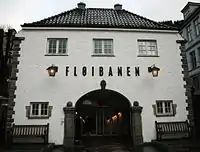 |
| Promsgate | An intermediate stop, which is situated one minutes walk from Skansen fire tower, at an elevation of 59 m (194 ft) above mean sea level. The stop is in the open, just above the exit from the tunnel from the lower terminus. Above this point, the line runs in the open air, with the exception of a short tunnel at the upper end of the passing loop. | .jpg.webp) |
| Fjellveien | An intermediate stop, at an elevation of 114 m (374 ft) above mean sea level, which gives access to scenic walks to the north and south of town. The stop is located just below the passing loop. When one car is halted here, the other car is stopped at Skansemyren. | 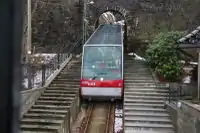 |
| Passing loop. Cars do not stop. | ||
| Skansemyren | An intermediate stop, at an elevation of 181 m (594 ft) above mean sea level, which is five minutes walk from sports arena. The stop is located just above the passing loop, partly in the open air and partly in the short tunnel that separates it from the loop. When one car is halted here, the other car is stopped at Fjellveien. | 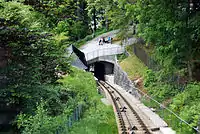 |
| Unnamed stopping point without platforms or passenger access. One car halts here when the other car stops at Promsgate. | ||
| Fløyen | Upper terminus, at an elevation of 320 m (1,050 ft) above mean sea level. The stop gives access to viewing terraces, a restaurant and cafe, and to the walking trails on the mountain of Fløyen. | 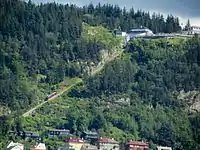 |
References
- "About the company". Fløibanen AS. Archived from the original on 12 September 2016. Retrieved 9 September 2016.
- "Fløibanen Funicular". visitnorway.com. Archived from the original on 12 September 2016. Retrieved 10 September 2016.
- "Fløibanen funicular". visitbergen.com. Retrieved 12 September 2016.
- "Fløibanen - The funicular cable car of Bergen". Fløibanen AS. Archived from the original on 17 July 2007. Retrieved 9 September 2016.
- "Heading for new heights" (PDF). Fløibanen AS. Archived from the original (PDF) on 12 April 2014. Retrieved 9 September 2016.
- "About Fløibanen". Fløibanen AS. Archived from the original on 13 September 2016. Retrieved 12 September 2016.
- "Fløibanen Timetable". Fløibanen AS. Archived from the original on 13 September 2016. Retrieved 12 September 2016.
- "Wheelchair access on Fløibanen funicular and Mount Fløyen". Fløibanen AS. Archived from the original on 13 September 2016. Retrieved 13 September 2016.
- "Fløibanen". DiscoveringNorway.com. Archived from the original on 17 September 2016. Retrieved 17 September 2016.
External links
 Media related to Fløibanen at Wikimedia Commons
Media related to Fløibanen at Wikimedia Commons- Fløibanen's official website
- Fløibanen web cam

